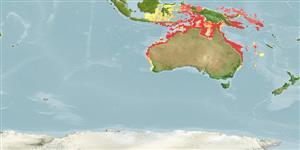Elasmobranchii (tubarões e raias) (sharks and rays) >
Orectolobiformes (Carpet sharks) >
Hemiscylliidae (Bamboo sharks)
Etymology: Hemiscyllium: hemi-, from hemisys (Gr.), half, presumably referring to similarity and/ or close affinity to Scyllium (=Scyliorhinus, now in Scyliorhinidae) and/or Chiloscyllium; skylion, Greek for dogfish or small shark. (See ETYFish); ocellatum: Latin for eyed, referring to conspicuous white-ringed black ocellus on flanks above pectoral fins. (See ETYFish).
More on author: Bonnaterre.
Environment: milieu / climate zone / depth range / distribution range
Ecologia
marinhas associadas(os) a recifes; intervalo de profundidade 0 - 50 m (Ref. 54540). Tropical; 1°S - 34°S, 112°E - 163°E (Ref. 54540)
Western Pacific: New Guinea and northern Australia. Possibly occurring in Malaysia, Sumatra (Indonesia), and the Solomon Islands.
Comprimento de primeira maturação / Tamanho / Peso / Idade
Maturity: Lm ?, range 60 - ? cm
Max length : 107 cm TL macho/indeterminado; (Ref. 247)
Espinhos dorsais (total): 0; Raios dorsais (total): 0; Espinhos anais 0; Raios anais : 0. Caudal fin with a pronounced subterminal notch but without a ventral lobe (Ref. 13575). Lateral ocellus not surrounded by large spots; spots present on head in front and below eyes (Ref. 13575).
Commonly found in shallow water of coral reefs (Ref. 6871). Often in tide pools (Ref. 13575). Feeds mainly on benthic invertebrates (Ref. 6871). Oviparous (Ref. 50449). Squirms when captured but cannot readily escape (Ref. 247). Survives well in aquariums (Ref. 6871). Has the ability to survive low oxygen conditions by switching of non-essential brain functions; apparently an adaption for hunting in tide-pools with low oxygen (Ref. 52022).
Ciclo de vida ou comportamento de acasalamento
Maturidade | Reprodução | Desova | Ovos | Fecundidade | Larvas
Oviparous, paired eggs are laid. Embryos feed solely on yolk (Ref. 50449). Prior to copulation, the male gets a good grasp of the female by by biting the body and even the gills (Ref. 49562, 51043).
Compagno, L.J.V., 1984. FAO Species Catalogue. Vol. 4. Sharks of the world. An annotated and illustrated catalogue of shark species known to date. Part 1 - Hexanchiformes to Lamniformes. FAO Fish. Synop. 125(4/1):1-249. Rome, FAO. (Ref. 247)
Status na Lista Vermelha da UICN (Ref. 130435)
Uso pelos humanos
Pescarias: sem interesse
Mais informação
ReferênciasAquaculturaPerfil para aquaculturaEstirpesGenéticaElectrophoresesHereditariedadeDoençasProcessamentoNutrientsConversão de massa
Ferramentas
Relatórios especiais
Baixar XML
Fontes da internet
Estimates based on models
Preferred temperature (Ref.
123201): 24.1 - 28, mean 26.9 °C (based on 262 cells).
Índice de diversidade filogenética (Ref.
82804): PD
50 = 0.5020 [Uniqueness, from 0.5 = low to 2.0 = high].
Bayesian length-weight: a=0.00407 (0.00181 - 0.00918), b=3.09 (2.89 - 3.29), in cm total length, based on LWR estimates for this (Sub)family-body shape (Ref.
93245).
Nível Trófico (Ref.
69278): 3.4 ±0.2 se; based on diet studies.
Resiliência (Ref.
120179): Baixo, tempo mínimo de duplicação da população 4,5 - 14 anos (Fec assumed to be <100).
Fishing Vulnerability (Ref.
59153): High vulnerability (64 of 100).
Nutrients (Ref.
124155): Calcium = 13.8 [2.7, 51.9] mg/100g; Iron = 0.395 [0.094, 1.067] mg/100g; Protein = 19.3 [17.1, 21.3] %; Omega3 = 0.0792 [, ] g/100g; Selenium = 30.9 [9.5, 86.3] μg/100g; VitaminA = 44.7 [15.7, 118.8] μg/100g; Zinc = 0.923 [0.453, 1.889] mg/100g (wet weight);
